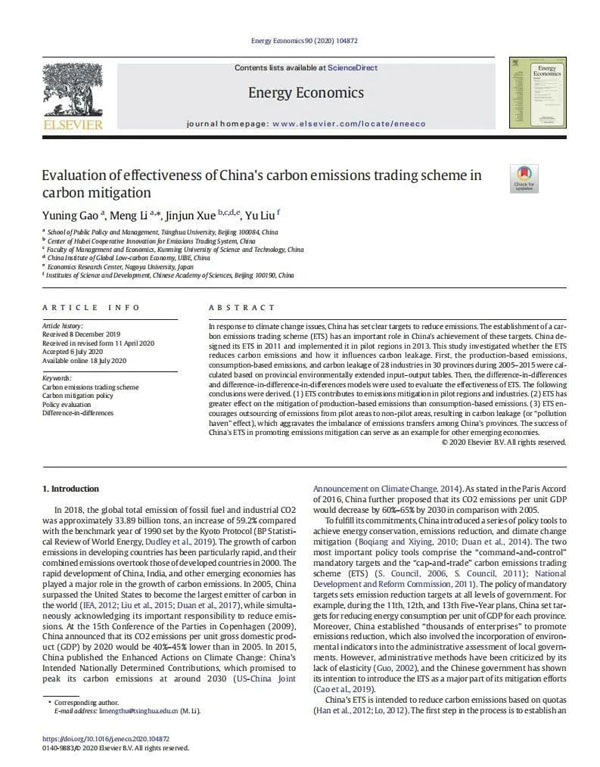Energy Economics
Volume 90, August 2020, 104872
| Received 8 December 2019
| Received in revised form 11 April 2020
| Accepted 6 July 2020
| Available online 18 July 2020
Evaluation of effectiveness of China's carbon emissions trading scheme incarbon mitigation
Yuning Gao a, Meng Li a,?, Jinjun Xue b,c,d,e, Yu Liu f
a School of Public Policy and Management, Tsinghua University, Beijing 100084, China
b Center of Hubei Cooperative Innovation for Emissions Trading System, China
c Faculty of Management and Economics, Kunming University of Science and Technology, China
d China Institute of Global Low-carbon Economy, UIBE, China
e Economics Research Center, Nagoya University, Japan
f Institutes of Science and Development, Chinese Academy of Sciences, Beijing 100190, China
 limengthu@tsinghua.edu.cn
limengthu@tsinghua.edu.cn
Abstract:In response to climate change issues, China has set clear targets to reduce emissions. The establishment of a carbon emissions trading scheme (ETS) has an important role in China's achievement of these targets. China designed its ETS in 2011 and implemented it in pilot regions in 2013. This study investigated whether the ETS reduces carbon emissions and how it influences carbon leakage. First, the production-based emissions, consumption-based emissions, and carbon leakage of 28 industries in 30 provinces during 2005–2015 were calculated based on provincial environmentally extended input–output tables. Then, the difference-in-differences and difference-in-difference-in-differences models were used to evaluate the effectiveness of ETS. The following conclusions were derived. (1) ETS contributes to emissions mitigation in pilot regions and industries. (2) ETS has greater effect on the mitigation of production-based emissions than consumption-based emissions. (3) ETS encourages outsourcing of emissions from pilot areas to non-pilot areas, resulting in carbon leakage (or “pollution haven” effect), which aggravates the imbalance of emissions transfers among China's provinces. The success of China's ETS in promoting emissions mitigation can serve as an example for other emerging economies.
碳排放权交易制度试点政策减排效果评估
高宇宁 李萌 薛进军 刘宇
高宇宁:294俄罗斯专享会华宇副教授、国情研究院副研究员;
李萌(通讯作者):294俄罗斯专享会、国情研究院博士后;
薛进军:日本名古屋大学国际经济政策研究中心教授;
刘宇:中国科学院科技战略咨询研究院研究员
【摘 要】
为了应对气候变化问题,中国提出了明确的的减排目标。碳排放权交易市场制度的建立,对于中国成功达成减排目标具有重要作用。中国于2011年通过了碳排放权交易试点政策,并于2013年在试点省市、试点行业陆续投入运行。
为检验碳排放交易权政策对于试点地区碳减排和碳泄露的政策效果,本文利用各地区扩展投入产出表核算了2005年至2015年中国30省28行业的生产碳排放和消费碳排放量及碳转移量,并基于省级行业三维面板数据分别使用双重差分模型以及三重差分模型考察碳市场政策对生产侧碳排放和消费侧碳排放的减排效果。
研究发现:
(1)碳排放权交易制度能够促进试点省份、试点行业节能减排。
(2) 碳排放权交易制度对生产侧碳排放的减排效果强于消费侧碳排放。
(3)碳排放权交易政策使得试点省市将更多碳排放转移到其他没有开始该项政策的省市,导致试点省市的碳排放外溢,存在“污染避难所”效应,在一定程度上加剧了我国省间碳不平衡的状态。
碳市场政策在中国能够有效促进减排,这对于其他国家尤其是新兴经济体的减排政策具有借鉴意义。
